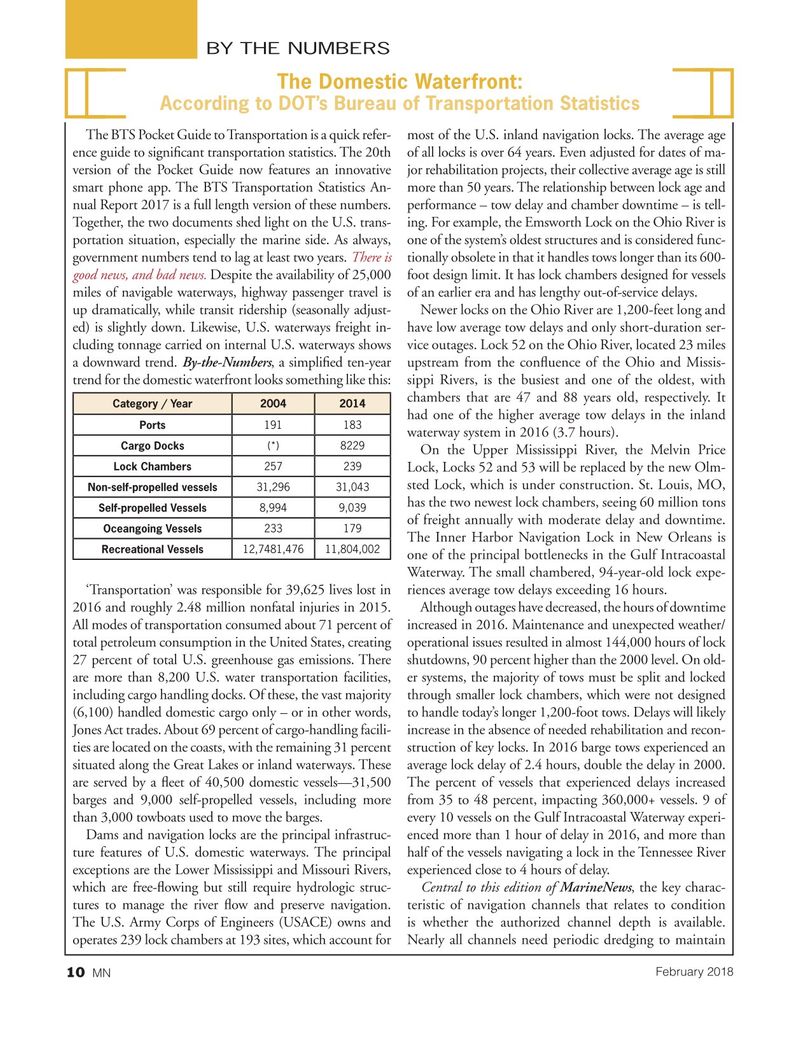
Page 10: of Marine News Magazine (February 2018)
Dredging & Marine Construction
Read this page in Pdf, Flash or Html5 edition of February 2018 Marine News Magazine
BY THE NUMBERS
The Domestic Waterfront:
According to DOT’s Bureau of Transportation Statistics
The BTS Pocket Guide to Transportation is a quick refer- most of the U.S. inland navigation locks. The average age ence guide to signi? cant transportation statistics. The 20th of all locks is over 64 years. Even adjusted for dates of ma- version of the Pocket Guide now features an innovative jor rehabilitation projects, their collective average age is still smart phone app. The BTS Transportation Statistics An- more than 50 years. The relationship between lock age and nual Report 2017 is a full length version of these numbers. performance – tow delay and chamber downtime – is tell-
Together, the two documents shed light on the U.S. trans- ing. For example, the Emsworth Lock on the Ohio River is portation situation, especially the marine side. As always, one of the system’s oldest structures and is considered func- government numbers tend to lag at least two years. There is tionally obsolete in that it handles tows longer than its 600- good news, and bad news. Despite the availability of 25,000 foot design limit. It has lock chambers designed for vessels miles of navigable waterways, highway passenger travel is of an earlier era and has lengthy out-of-service delays.
up dramatically, while transit ridership (seasonally adjust- Newer locks on the Ohio River are 1,200-feet long and ed) is slightly down. Likewise, U.S. waterways freight in- have low average tow delays and only short-duration ser- cluding tonnage carried on internal U.S. waterways shows vice outages. Lock 52 on the Ohio River, located 23 miles a downward trend. By-the-Numbers, a simpli? ed ten-year upstream from the con? uence of the Ohio and Missis- trend for the domestic waterfront looks something like this: sippi Rivers, is the busiest and one of the oldest, with chambers that are 47 and 88 years old, respectively. It
Category / Year 20042014 had one of the higher average tow delays in the inland
Ports 191 183 waterway system in 2016 (3.7 hours).
Cargo Docks (*) 8229
On the Upper Mississippi River, the Melvin Price
Lock Chambers 257239
Lock, Locks 52 and 53 will be replaced by the new Olm- sted Lock, which is under construction. St. Louis, MO,
Non-self-propelled vessels 31,29631,043 has the two newest lock chambers, seeing 60 million tons
Self-propelled Vessels 8,9949,039 of freight annually with moderate delay and downtime.
Oceangoing Vessels 233179
The Inner Harbor Navigation Lock in New Orleans is
Recreational Vessels 12,7481,47611,804,002 one of the principal bottlenecks in the Gulf Intracoastal
Waterway. The small chambered, 94-year-old lock expe- ‘Transportation’ was responsible for 39,625 lives lost in riences average tow delays exceeding 16 hours.
2016 and roughly 2.48 million nonfatal injuries in 2015. Although outages have decreased, the hours of downtime
All modes of transportation consumed about 71 percent of increased in 2016. Maintenance and unexpected weather/ total petroleum consumption in the United States, creating operational issues resulted in almost 144,000 hours of lock 27 percent of total U.S. greenhouse gas emissions. There shutdowns, 90 percent higher than the 2000 level. On old- are more than 8,200 U.S. water transportation facilities, er systems, the majority of tows must be split and locked including cargo handling docks. Of these, the vast majority through smaller lock chambers, which were not designed (6,100) handled domestic cargo only – or in other words, to handle today’s longer 1,200-foot tows. Delays will likely
Jones Act trades. About 69 percent of cargo-handling facili- increase in the absence of needed rehabilitation and recon- ties are located on the coasts, with the remaining 31 percent struction of key locks. In 2016 barge tows experienced an situated along the Great Lakes or inland waterways. These average lock delay of 2.4 hours, double the delay in 2000. are served by a ? eet of 40,500 domestic vessels—31,500 The percent of vessels that experienced delays increased barges and 9,000 self-propelled vessels, including more from 35 to 48 percent, impacting 360,000+ vessels. 9 of than 3,000 towboats used to move the barges. every 10 vessels on the Gulf Intracoastal Waterway experi-
Dams and navigation locks are the principal infrastruc- enced more than 1 hour of delay in 2016, and more than ture features of U.S. domestic waterways. The principal half of the vessels navigating a lock in the Tennessee River exceptions are the Lower Mississippi and Missouri Rivers, experienced close to 4 hours of delay.
which are free-? owing but still require hydrologic struc- Central to this edition of MarineNews, the key charac- tures to manage the river ? ow and preserve navigation. teristic of navigation channels that relates to condition
The U.S. Army Corps of Engineers (USACE) owns and is whether the authorized channel depth is available. operates 239 lock chambers at 193 sites, which account for Nearly all channels need periodic dredging to maintain
February 2018
MN 10

 9
9

 11
11
